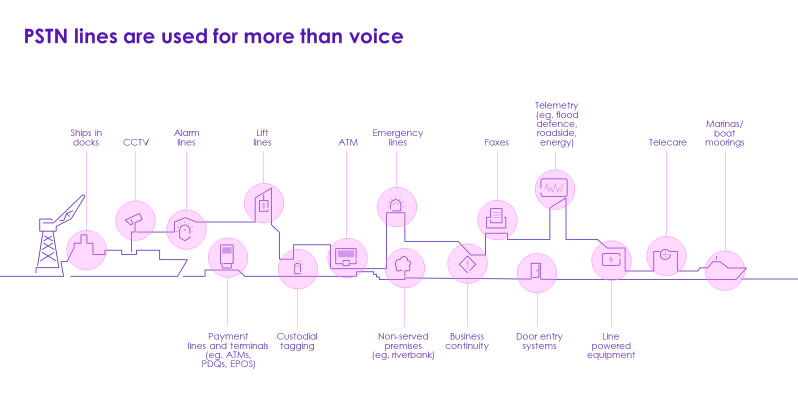Traditional phone lines aren't just for making voice calls. There are also various products and services that rely on the network, such as alarms, telecare devices, lifts, modems and more. If you use or provide equipment that connects to the analogue network, it's important to understand how the switch-off could affect your services.
The Public Switch Telephone Network (PSTN) which has supported phone and broadband services for decades is being switched off. By the end of January 2027, UK customers and businesses will be migrated to a fully digital network that uses Internet Protocol (IP). Find out more about why this transition is happening.
This won’t just affect voice services; it may also affect other devices such as alarms, Point-of-Sale (Pos) machines, door entry systems, CCTV, fax machines, and more.
Since 2018, we’ve been working with customers, manufacturers, and industries to understand how our customers use their telephone lines. These are captured as use cases to help us develop the right solutions to successfully migrate customers ahead of the PSTN switch.
Any equipment connected to fixed phone lines will need to be compatible with one of our fully digital solutions such as Pre-digital Phone Line (PDPL), Analogue Terminal Adapters (ATAs) or Internet Protocol (IP) to continue working after the switch off. If you’re a supplier of these products or services, testing may be required to ensure they continue to work beyond January 2027.
We’re inviting customers and vendors to test their devices for free at our Digital Services Lab at Adastral Park, near Ipswich. Early testing allows us to check that your devices are compatible with our digital network and ensure the right solutions are in place to support you through the switch-off.
-
I am a business or vendor with equipment other than phones connected to my phone line.
The switch to all-IP affects more than just phones, it may also impact devices like alarms, Point-of-Sale (Pos) machines, door entry systems, CCTV and more. Now is the time to check with your provider to make sure your devices will continue working after the PSTN switch off.
We’re encouraging customers to test their devices at our free Digital Services Lab to ensure they stay connected throughout the migration to IP.
-
I am a residential customer and have equipment other than phones connected to my phone line.
We recommend speaking to your device provider about upgrading your equipment to work with the digital phone service. They’ll be able to talk you through the options to make sure your devices stay connected after the PSTN switch-off.
-
How can I check if my devices are compatible with digital voice?
At Adastral Park, we have a fully funded Digital Services Lab where device providers can test their equipment with our all-IP and Pre-Digital Phone Line capabilities. Get in touch to book your visit.
-
How do I find out if my device provider has tested their equipment at the lab?
If you’re using a special service device and want to check whether it’s compatible with our fully digital solutions, you can check if your device provider has tested their equipment. Please note that BT does not endorse any products or companies listed on this site. For further information, please contact the device provider directly.
-
What types of devices have been tested in the labs?
The following device types have been tested in our labs: handsets, phone ancillaries, telecare devices, lift auto diallers, power meters, telemetry devices, security alarms, and devices used by vulnerable customers.
-
What products are available in the labs for testing?
Products available in the labs for testing include PDPL (exchange-based analogue phone service), Cloud Voice Express, Cloud Voice, Cloud Works, and CV SIP. Testing also covers all access products such as FTTP, SOGEA, and SOADSL, as well as all BT hubs, including Smart Hub 2 and Smart Hub 3. There is also a selection of ATAs and emulators available for testing, including single-port and multi-port ATAs, as well as ISDN emulators.
For BT and EE consumer services, Digital Voice lines are also available for testing, including the dedicated landline.






